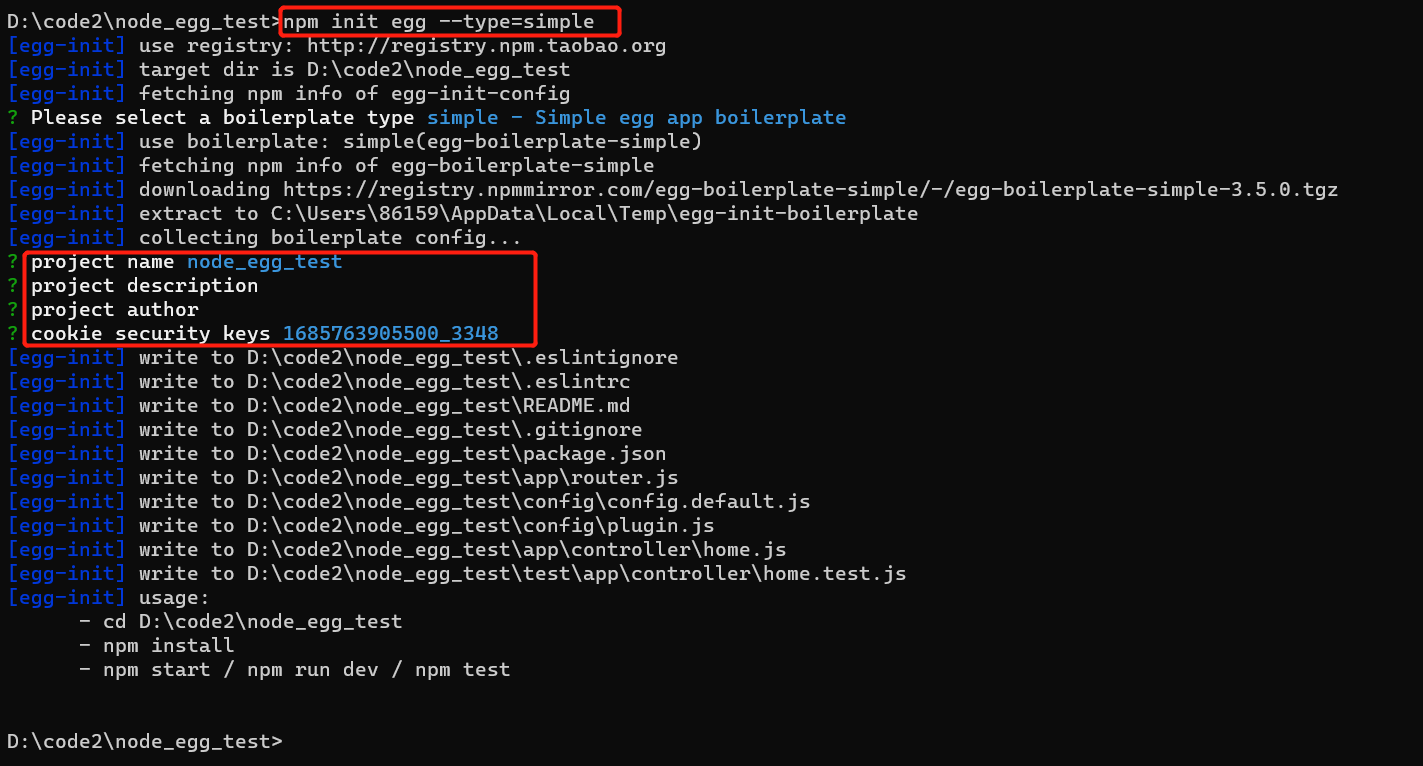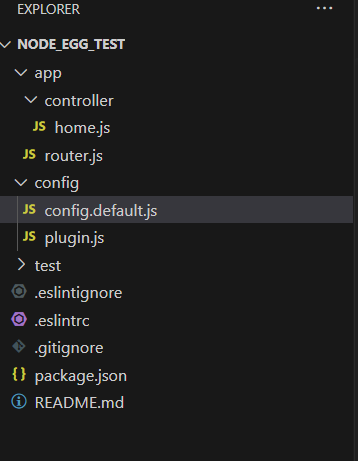nodejs使用eggjs创建项目,接入influxdb完成单表增删改查
转载请注明出处:
1.Eggjs 特性:
Eggjs 是 Node.js 服务端应用开发框架,它提供了一套约定,使开发者能够快速搭建、开发和部署应用。以下是 Egg.js 的一些特性和作用:
- 框架内置了基于约定的目录结构、约定的扩展机制和一些常用的插件,可以帮助开发者快速搭建应用。
- Egg.js 遵循 MVC 的分层架构,使代码更加清晰易于维护。
- Egg.js 通过插件机制提供了丰富的功能扩展,例如:数据库访问、模板引擎、Session、身份验证、安全等。
- Egg.js 提供了一套完善的开发调试工具,例如:自动重启、自动刷新、自动测试等。
- Egg.js 提供了一套完整的部署方案,例如:多进程部署、负载均衡等。
2..使用egg初始化项目
首先需要保证本地具有nodej的环境,使用egg初始化项目
npm init egg --type=simple
在执行该命令的中间过程,需要输入 项目名称、项目描述、项目作者以及安全的配置key

创建之后的项目导入vscode之后如下图所示:

3.约定规则
1 app/router.js:用于配置URL路由规则;
2 app/controller/** :用于解析用户的输入,处理后返回相应的结果;
3 app/service/: 用于编写业务逻辑层;
4 app/public/: 用于放置静态资源;
5 config/config.{env}.js: 用于编写配置文件;
6 config/plugin.js 用于配置需要加载的插件;
4.接入InfluxDB配置
egg提供5种配置文件:
config.default.js:默认配置文件;
config.local.js:开发环境下的配置,与默认配置合并,同名则覆盖默认配置;
config.prod.js:生产环境下的配置,与默认配置合并,同名则覆盖默认配置;
config.test.js:测试环境下的配置,与默认配置合并,同名则覆盖默认配置;
config.unittest.js:单元测试环境下的配置,与默认配置合并,同名则覆盖默认配置;
在 config.default.js 中添加influxdb相关的配置文件,并设置日志级别
config.influxdb = { host: 'influx_db_host', port: 8086, database: 'influx_db', username: 'influx_user', password: 'influx_pwd' } config.log = { level: 'DEBUG', consoleLevel: 'DEBUG', }
5. 创建user表
在app/model/user.js中创建user表:
module.exports = app => { const { InfluxDB } = require('influx'); const { host, port, database, username, password } = app.config.influxdb; const influx = new InfluxDB({ host, port, database, username, password, schema: [ { measurement: 'user', fields: { name: InfluxDB.FieldType.STRING, age: InfluxDB.FieldType.INTEGER, }, tags: [ 'id' ] } ] }); class User extends app.Service { async create(user) { return influx.writePoints([ { measurement: 'user', tags: { id: user.id }, fields: { name: user.name, age: user.age } } ]); } async find(id) { return influx.query(`select * from user where id='${id}'`); } async update(id, user) { return influx.writePoints([ { measurement: 'user', tags: { id }, fields: { name: user.name, age: user.age } } ]); } async delete(id) { return influx.query(`delete from user where id='${id}'`); } } return User; };
6. user表的增删改查
在app/controller/home.js中编写增删改查的接口:
const Controller = require('egg').Controller;
class HomeController extends Controller {
async create() {
const { ctx } = this;
const { id, name, age } = ctx.request.body;
await ctx.service.user.create({ id, name, age });
ctx.body = { success: true };
}
async find() {
const { ctx } = this;
const { id } = ctx.query;
const result = await ctx.service.user.find(id);
ctx.body = result;
}
async update() {
const { ctx } = this;
const { id } = ctx.params;
const { name, age } = ctx.request.body;
await ctx.service.user.update(id, { name, age });
ctx.body = { success: true };
}
async delete() {
const { ctx } = this;
const { id } = ctx.params;
await ctx.service.user.delete(id);
ctx.body = { success: true };
}
}
module.exports = HomeController;
7.在app/router.js中配置路由
module.exports = app => { const { router, controller } = app; router.post('/user', controller.home.create); router.get('/user', controller.home.find); router.put('/user/:id', controller.home.update); router.delete('/user/:id', controller.home.delete); };
8.启动并测试
启动
- 开发环境:
npm run dev - 生产环境:
npm start
停止
npm run stop

使用curl命令测试接口:
# 创建user $ curl -X POST -H "Content-type: application/json" -d '{"id": "1", "name": "Alice", "age": 20}' http://localhost:7001/user # 查找user $ curl http://localhost:7001/user?id=1 # 更新user $ curl -X PUT -H "Content-type: application/json" -d '{"name": "Bob", "age": 30}' http://localhost:7001/user/1 # 删除user $ curl -X DELETE http://localhost:7001/user/1
9.目录结构及所有文件
egg-influxdb-demo ├── app │ ├── controller │ │ └── home.js │ ├── model │ │ └── user.js │ ├── router.js │ ├── service │ │ └── user.js │ └── view │ └── home.tpl ├── config │ ├── config.default.js │ └── plugin.js ├── package.json └── README.md






【推荐】国内首个AI IDE,深度理解中文开发场景,立即下载体验Trae
【推荐】编程新体验,更懂你的AI,立即体验豆包MarsCode编程助手
【推荐】抖音旗下AI助手豆包,你的智能百科全书,全免费不限次数
【推荐】轻量又高性能的 SSH 工具 IShell:AI 加持,快人一步
· 25岁的心里话
· 闲置电脑爆改个人服务器(超详细) #公网映射 #Vmware虚拟网络编辑器
· 基于 Docker 搭建 FRP 内网穿透开源项目(很简单哒)
· 零经验选手,Compose 一天开发一款小游戏!
· 一起来玩mcp_server_sqlite,让AI帮你做增删改查!!
2021-06-03 Linux复制安装 jdk 环境